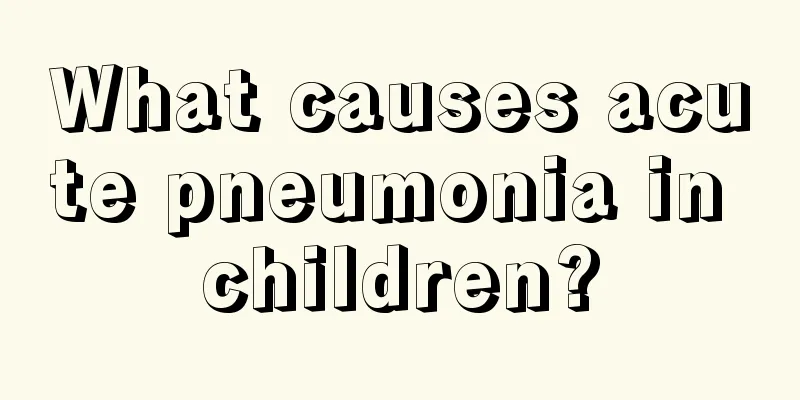Consequences of a sunken anterior fontanelle in babies

|
From the ten months of pregnancy to the baby's growth into an adult, parents play an important role in their babies' lives. Therefore, in the process of raising their babies, parents should pay more attention to their babies' physical changes. According to advanced medical technology, when the baby's anterior fontanelle is sunken, it means that there is a problem with the body's function, such as a lack of a lot of water in the body. At this time, parents should replenish the baby with water in time. So what problems and consequences will a sunken anterior fontanelle bring to the baby? 1. Premature closure and shrinkage The size of the bregma is closely related to brain development. Microcephaly and brain maldevelopment cause the anterior fontanelle to shrink and almost close. Microcephaly can be caused by chromosomal abnormalities, metabolic diseases, intrauterine infection, intrauterine malnutrition and other factors. The brain development of the fetus is retarded at 5 months of gestation. The head circumference at birth is slightly smaller than that of a normal newborn, and the anterior fontanelle is small or almost closed. With age, the facial bones develop normally, but the frontal bone and temporal bones on both sides tilt upward, the occipital bone is flat, the skull appears smaller, and the top of the head is pointed, so it is also called acrocephaly. 2. Delayed closure and expansion of “delayed closure” 1. Vitamin D deficiency rickets often causes abnormal calcium and phosphorus metabolism and changes in the body's voice quality. The changes in the head alone are very significant. Osteomalacia often occurs in the occipital bone and the center of the parietal bone. When you press lightly with your fingers, the bone sinks slightly inward, and it bounces back immediately after you release your hand. It feels like pressing a ping-pong ball with your hand, so it is called "ping-pong head." Symmetrical skull domes appear on the top of the forehead, making the head square. The fontanelle is too large or does not close until 2” or 3 years old. There is also delayed tooth eruption. 2. Cretinism, also known as cretinism, is caused by congenital hypothyroidism and general developmental retardation. In addition to being short, the head is quite characteristic, with a large head, a large and late-closing fontanelle, delayed tooth eruption, small and sparse teeth, edema-like face, low nose bridge, wide-set eyes, narrow palpebral fissures, swollen eye sockets, thick lips, a large and thick tongue, and drooling. 3. Bloating and tension 1. When infants suffer from purulent meningitis (chemoencephalitis) or viral encephalitis (sick encephalitis), the prominent symptom is bulging or tension of the anterior fontanelle. In addition, there are fever, vomiting, irritability or even fright, and abnormal cerebrospinal fluid test results. If complications occur during the course of the disease, such as subdural effusion, the anterior fontanelle will become continuously bulging and tight. 2. Intracranial hemorrhage is a common late-onset vitamin D deficiency in infants, which can easily lead to intracranial hemorrhage. At the same time, there may be blood accumulation in the subdural space. At this time, the anterior fontanelle may bulge and become tense, and anemia and cerebral screams may appear for a short period of time. 4. Concavity means that the anterior bregma is lower than the surrounding tissue. 1. Dehydration means losing a lot of water in the body, such as frequent vomiting or diarrhea. The prominent manifestations are a sunken anterior fontanelle accompanied by dry mouth, oliguria and sunken eye sockets. 2. Malnutrition n--Infants with malnutrition are malnourished due to improper feeding and various diseases. The anterior fontanelle is sunken, and the subcutaneous fat is thin all over the body. The cheeks look fleshless, the baby is skinny, and the body's activity ability is reduced. Whether a baby can grow up healthily is closely related to its parents. When encountering problems such as a sunken anterior fontanelle in a baby, parents should send the baby to the hospital for treatment in time. They should not blindly follow the trend and think it is a trivial matter. The resistance and immunity of babies a few months old are not yet fully developed, so parents should pay more attention and pay attention, and always observe the baby's physical changes. |
<<: Reasons for green stools in 2-month-old babies
>>: Why does my 2-month-old baby have sour and smelly stools?
Recommend
What is the disease of small pimples on children's hands?
Some children often get small bumps on their hand...
The best treatment for cerebral palsy
Cerebral palsy is a disease that often occurs in ...
Methods of dietary supplements for anemia in babies
It is a very troublesome thing for a baby to have...
Is it really okay for a three-year-old baby to take a bath every day?
When taking care of their babies, many parents st...
Learn to do this so that your child will no longer be irritable and angry
Nowadays, it is very common for children to lose ...
What should I do when my child catches a cold?
Children have relatively poor body resistance, so...
How to deal with a sudden fever in the middle of the night
The phenomenon of babies suddenly having a fever ...
What’s going on if my child has bubbles in his throat?
The baby has bubbles in his throat. This is mostl...
Is ADHD harmful to elementary school students?
Primary school students are the group most likely...
How to make breakfast for children
Many parents often have a headache because their ...
How to solve the problem of enlarged tonsils in children?
Once the tonsils are enlarged, obvious pain will ...
My six-month-old baby always cries when he sleeps at night
A six-month-old baby is in a critical period of g...
Why is the girl's lower body itchy?
In most people's impressions, bacterial infec...
Can I get a vaccination for diaper rash?
Babies' skin is relatively delicate, and they...
What are some good ways to develop nap habits for children?
Babies and toddlers sleep for a long time, so mos...









